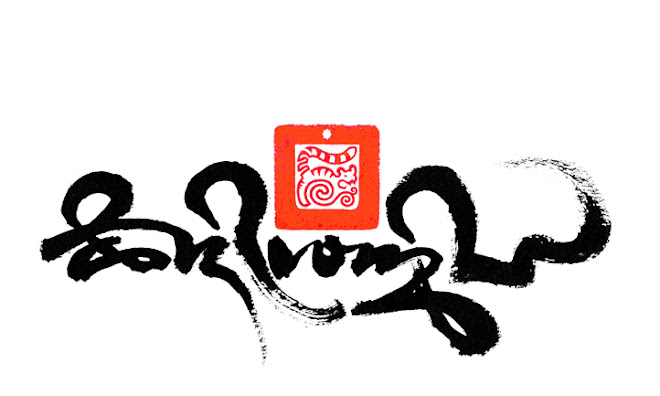 |
| “Sacred Mantra” 73x56 cm Chinese ink and Japanese mineral paint on Heavy watercolour paper, created by © Tashi Mannox 2010 for the III International Exhibition of Calligraphy 2010 |
The description of the above calligraphy art piece features two main elements of sacred calligraphy:
1. The Mani mantra in the White vertical Phags-pa script:
The neo-Mongolian/Tibetan Phags-pa script was devised as a uniformed style by the Tibetan Lama ‘Blo-gros rGyal-mtshan’, during the regime of the Great Kublai Khan 1260-1294.
Phags-pa was also known as the new Mongolian script called Horyig in Tibetan. This was imperially imposed as a national script of the Mongol empire of the Yuan dynasty 1271-1368 encompassing all of China.
This particular Phags-pa script style used by Tashi to represent the famous Mani mantra of compassion, originates in 1348. This was discovered scribed on stone tablets at Juyonguan in China, located at the nearest section of the Great Wall to Beijing.
Only fragments of this beautiful form of Phags-pa style survives today, great effort and research were made to resurrect the Mani mantra to a correct representation in this rare script style, much due to the guidance of Andrew West, who is an expert in ancient scripts of the Far East.
The Phags-pa script bears some resemblance to Tibetan but differs distinctly in that it is written vertically downwards in columns running from left to right, much like Mongolian. Units are often formed of several characters that are separated by spaces.
From top to bottom the Phags-pa script reads om ma ni pad me hum.
2. The wishing prayer occupies horizontal lines of dark indigo ink in the Tibetan Dru-tsa script style:
Dru-tsa is one of the several U-med script styles, which is traditionally used for more ornamental calligraphy. The cursive form of the characters lends its self well to a more free style calligraphy that can be skilfully expressed in longer elegant tails and vowel signs.
In contrast to the architectural structure of the Phags-pa script, is a wishing prayer to engender a pure perception of our world being a divine heavenly realm, that all beings are the embodiment of loving kindness; the Bodhisattva Avalokitesvara and all sounds vibrate the sound of the six-syllable mantra. A full translation of this pure perception prayer is shown below:
Integrating everything into the spiritual path:
Each and every being in this universe is Avalokiteshvara, the embodiment of compassion,
Every sound heard hums the melody of the six sacred syllables,
This very place is truly the Pure Land of Great Bliss,
Devoid of any actual reality, like a magic show, like a dream.
It is as though we had already been reborn there.
As we cultivate “pure perception” with great joy, all veils are cleared.
One should practice “pure perception” in the way explained above.
Translation by Katia Holmes 2010
The blue ‘Utpala’ lotus represents transformation from relative to ultimate; on the open lotus is a white moon disc, which represents stainless purity. Emanating vertically from the seat of the lotus is the Mani mantra. The background of green to blue swirls suggest the water on the pond of Saṃsāra, the ocean of suffering for which compassion and understand is engendered.
oṃ maṇipadme hūṃ

The Mani mantra in 'high' Uchen script style, © Tashi Mannox 2010.
This year the Contemporary Calligraphy Museum hosts The III International Exhibition of Calligraphy 2010 in the historical Russian town of Velikly Novgorod. The main theme of the exhibition is 'Sacred Calligraphy', which the above piece called 'Sacred Mantra', was create by Tashi and donated to the Contemporary Calligraphy Museum especially for this particular calligraphy collection.
The exhibition extravaganza features art pieces of world class calligraphy artists from 43 countries, opens and runs September 10th -12th 2010.
❖

High Uchen script style on a base of Lapis-lazuli stone effect, this translates as
"(Spontaneously) Sacred Calligraphy". The most precious of Tibetan calligraphy is said to be embossed in gold on tablets of Lapis-lazuli stone, of which this art piece emulates. © Tashi Mannox 2010.
❖
